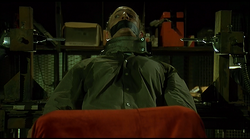| Movies |
| “ | Awake already, Jeff? I need more powerful tranquillizers next time. Don't cry. I've given your life a purpose. You're a test subject for something greater than yourself. | ” |
— Jigsaw speaks to Jeff.[src]
| ||
Jeff Ridenhour is a fictional character from the Saw franchise. He serves as a minor character in the first Saw film.
He was portrayed by Ned Bellamy.
Biography[]
Abduction[]
Not much is known about Jeff Ridenhour's past. However, one day he was targeted by John Kramer, better known as the Jigsaw Killer. After abducting him, he took him to his lair in an abandoned mannequin factory at 213 Stygian Street and strapped him to a mechanical chair before leaving his hideout again. (Saw)
Captivity[]

Jeff is found by Tapp and Sing
Shortly afterward, Detective David Tapp and Detective Steven Sing, two homicide detectives who worked for the Metropolitan Police Department, managed to find and break into the factory. Armed with a shotgun, Sing broke through the front door and entered the building, followed by Tapp, who gave him cover. Upon going upstairs and examining the location, they found a box with tiny figures that the killer had used to visualize another deadly game, which Jigsaw had already planned for the future. Furthermore, they found a pig mask used by Jigsaw for abducting his victims and a mechanical ventriloquist puppet named Billy that Jigsaw used to communicate with them. Moments later, they suddenly caught a sound coming from under a large red cloth. Upon investigating the noise, they discovered Jeff, still strapped to the mechanical chair. However, when they wanted to free him, they heard a nearby elevator. Eager to finally arrest the killer, Sing initially refused to follow Tapp's order, who told him to hide until they got a better look at Jigsaw, but ultimately gave in. The detectives quickly put the cloths back on Jeff and the puppet and went into hiding. (Saw)
Escape[]

Jeff in his trap
Moments later, Jigsaw arrived, disguised with a black cloak and hood. Tapp and Sing observed him as he approached Jeff and told him that he wanted to use him to test a bigger project. At this moment, the detectives left their hiding spot and aimed their weapons at Jigsaw. Jigsaw reacted quickly and activated the mechanical chair by stepping on a pressure button on the floor. Thereby, two drills started to approach Jeff's head from both sides. While Sing desperately tried to deactivate the contraption, Tapp held Jigsaw at gunpoint. Even though Jigsaw told them that the key to the trap was in a box next to Jeff, Sing couldn't find the right one in time as there were dozens of keys attached to the key ring. In the last nick of time, Sing saved Jeff nonetheless by shooting the drills. However, the shots distracted Tapp and allowed Jigsaw to slash his throat with a hidden blade and run away. Sing pursued him and shot him in a hallway, causing him to collapse. Thinking that he was dead, Sing approached his body and thereby stepped on a tripwire. This carelessness proved to be fatal as the wire triggered another trap, which caused Sing to be killed by four shotguns attached to a ceiling beam. Afterward, Jigsaw, who wore some kind of bulletproof body armor under his cloak, left the factory without any significant injuries. Tapp, who survived his injury, was saved later on, along with Jeff Ridenhour. (Saw)
Personality[]
Not much can be said about Jeff Ridenhour's personality due to his short screen time.
Trivia[]
- In an early script draft for Saw IV, Jeff was planned to make an appearance as the test subject forced to watch the progress of Special Agent Peter Strahm and Special Agent Lindsey Perez throughout their own game. In the script, his name was changed to "Ned Baker."
- Jeff Ridenhour is one of the many characters in the franchise whose reasons behind their tests are unknown, but some fans theorized that he might have been the pedophile dentist mentioned by David Tapp to Dr. Lawrence Gordon earlier in the first film. If that were the case, the trap he was strapped to might have been intentionally inspired by a dental chair.
Appearances and References[]
| Films | |||||||||
| Saw | Saw II | Saw III | Saw IV | Saw V | Saw VI | Saw 3D | Jigsaw | Spiral | Saw X |
| Flashback | Absent | Absent | Absent | Mentioned | Absent | Absent | Absent | Absent | Absent |
| Other Media | |||||
| "Saw" (2003 Short) |
Saw: Rebirth (2005 Comic) |
Full Disclosure Report | The Scott Tibbs Documentary | Saw: The Video Game | Saw II: Flesh & Blood |
| Absent | Absent | Absent | Absent | Appears | Mentioned |
